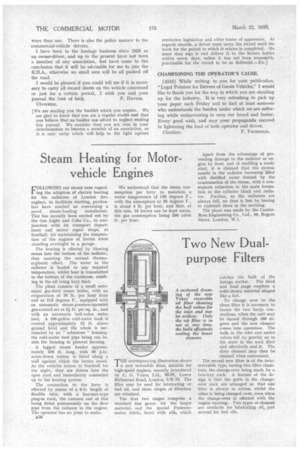Steam Heating for Motor vehicle Engines
Page 44

If you've noticed an error in this article please click here to report it so we can fix it.
FOLLOWING our recent note regarding the adoption of electric heating for the radiators of London fireengines, to facilitate starting, particulars have reached us concerning a novel steam-heating installation. This has recently been carried out by the Gas Light and Coke Co., in conjunction with its transport department and motor repair shops, at Southall, for maintaining the temperature of the engines of lorries when standing overnight in a garage.
The heating is effected by blowing steam into the bottom of the radiator, thus assisting the normal thermosyphonic effect. The water in the radiator is heated to any required temperature, whilst heat is transmitted to the bottom of the crankcase, resulting in the oil being kept fluid.
The plant consists of a small automatic gas-fired steam boiler, with an evaporation of 70 lb. per hour from and at 212 degrees F., equipped with an automatic steam-pressure-operated gas-control set at 24 lb. per sq. in., and with an automatic ball-valve water feed. A 100-gallon cold-water tank is erected approximately 12 ft. above ground level and the whole is surrounded by an " asbestone " housing, the cold-water feed pipe being run inside the housing to prevent freezing.
A lagged steam header approximately 200 ft. long, with 20 fin. screw-down valves, is fitted along a wall against which the lorries stand. As the vehicles return to Southall for the night, they are driven into the open yard and immediately connected up to the heating system.
The connection to the lorry is effected by means of a 6-ft. length of flexible tube, with a bayonet-type plug-in cock, the concave end of this being fitted permanently on the .flow pipe from the radiator to the engine. The operator has no joint to make.
B30
We understand that the steam consumption per lorry to maintain a water temperature of 130 degrees F., with the atmosphere at 35 degrees F., is about 4 lb. per hour, and that, at this rate, 16 lorries can be kept warm, the gas consumption being 200 cubic ft. per hour.
TlE accompanying illustration shows a new reversible filter, suitable for high-speed engines, recently introduced by C. G. Vokes, Ltd., 95-97, Lower Richmond Road, London, S.W.15. The filter may be used for lubricating or fuel oil, and three stages of filtration are obtained.
The first two stages comprise a standard fine gauze for the larger material, and the special Protectomotor fabric, faced with silk, which
Apart from the advantage of preventing damage to the radiator or engine by frost, and of enabling a ready start, it is claimed that the system results in the radiator becoming filled with distilled water formed by the condensation of the steam, with a consequent reduction in the scale formation in the cylinder block and radiator. Further, as the radiators are always fun, no time is lost by having to replenish them in the morning.
The plant was made by the CarrierRoss Engineering Co., Ltd., 99, Regent Street, London, W.I.




























































































